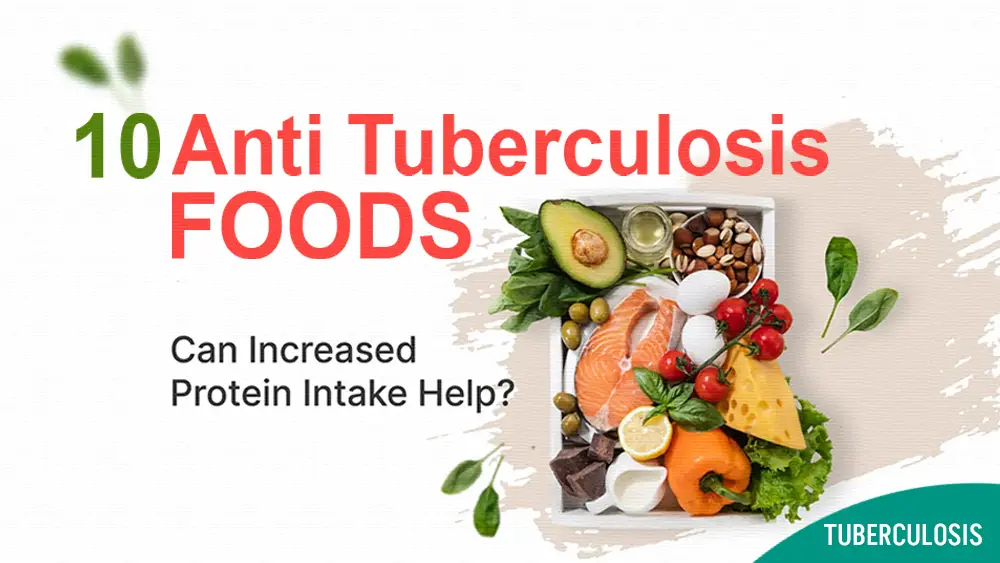
HEALTH BLOG
Why These 10 Anti-Tuberculosis Foods Should Be On Your Plate
-
 Rahul Priydarss
Rahul Priydarss - March 24, 2024
Discover the top 10 anti-tuberculosis foods that can support your immune system and overall health. Learn about the nutritional benefits of these foods and how they may help in managing tuberculosis. From lean proteins to immune-boosting fruits and vegetables, find out which foods to incorporate into your diet for optimal health. Stay informed and take control of your well-being with these nutrient-rich options. Improve your health today with our expert recommendations.
Tuberculosis Introduction:
Tuberculosis (TB) stands as one of the oldest and most persistent infectious diseases known to humanity, with a history dating back thousands of years. It is caused by Mycobacterium tuberculosis, a bacterium that primarily affects the lungs but can also target other organs and systems in the body. Despite considerable advancements in medicine, TB continues to pose a significant global health challenge, particularly in regions with limited resources and poor healthcare infrastructure.

Table of Contents
What is Mycobacterium Tuberculosis(MTB):
MTB is a unique bacterium with a tough outer shell that allows it to survive harsh environments and resist some antibiotics. This characteristic makes TB more challenging to treat compared to other bacterial infections.
The Spectrum of Tuberculosis(TB) Infection:
Not everyone infected with MTB develops the active disease. There are two main stages of TB infection.
1- Latent TB Infection: This stage represents a dormant state. The bacteria are present in the body, but they are not multiplying and causing illness. People with latent TB infection are not contagious and typically don’t experience any symptoms. However, a small percentage (around 10%) of latent infections progress to active TB disease, especially if the immune system weakens.
2- Active TB Disease: This stage signifies a full-blown infection. The bacteria actively multiply and cause tissue damage, leading to the characteristic symptoms of TB. People with active TB disease can spread the infection through the air when they cough, sneeze, or talk.
Transmission of Tuberculosis:
TB is spread through the air when an infected person coughs, sneezes, or talks. People nearby can inhale the bacteria and become infected. Close and prolonged contact with an infected individual increases the risk of transmission.
Symptoms of Tuberculosis:
TB symptoms can vary depending on the stage of the infection and the part of the body affected. Common symptoms include.
- Major cough
- Chest pain
- Coughing with blood or sputum
- Fatigue
- Fever
- Night sweats
- Unintended weight loss
Importance of Nutrition in Tuberculosis Treatment:
Nutrition plays a crucial role in the management and treatment of tuberculosis (TB). Adequate nutrition supports the body’s immune response, enhances the effectiveness of anti-TB medications, and promotes overall recovery. Here’s why nutrition is essential in TB treatment.
Understanding the Role of Nutrition in Fighting Tuberculosis:
Tuberculosis Food a critical role in the management and treatment of tuberculosis (TB), a contagious bacterial infection primarily affecting the lungs. Adequate nutrition is essential for supporting the body’s immune response, enhancing the effectiveness of anti-TB medications, and promoting overall recovery. Here’s an exploration of the significance of nutrition in combating TB.
1. Boosting Immune Function: Proper nutrition is fundamental for maintaining a robust immune system, which is crucial for combating TB infection. Malnutrition weakens the immune response, making individuals more susceptible to TB and increasing the risk of developing active disease. Essential nutrients like vitamins A, C, D, E, zinc, selenium, and iron are vital for strengthening the immune system and improving the body’s ability to fight off TB bacteria.
2. Enhancing Medication Efficacy: Anti-TB medications are essential for TB treatment, but malnutrition can hinder their absorption and effectiveness. Inadequate nutrition may lead to treatment failure and the emergence of drug-resistant TB strains. Optimal nutrition ensures the proper absorption of medications, maximizing their therapeutic effects, and reducing the risk of treatment failure.
3. Supporting Recovery and Tissue Repair: TB infection and the resulting inflammatory response can cause tissue damage, especially in the lungs. Adequate nutrition provides the necessary nutrients for tissue repair and regeneration, facilitating recovery from TB-related damage and improving lung function. Protein, in particular, is essential for tissue repair and maintaining muscle mass, which may be depleted during TB infection.
4. Preventing Wasting and Weight Loss: TB infection often leads to weight loss and wasting due to decreased appetite, increased metabolic demands, and nutrient malabsorption. Malnutrition and weight loss further weaken the body’s defenses and exacerbate TB symptoms. Proper nutrition helps prevent wasting, maintains a healthy body weight, and preserves lean body mass, crucial for optimal health and recovery during TB treatment.
5. Minimizing Treatment Side Effects: Anti-TB medications can cause adverse effects such as gastrointestinal disturbances, nausea, and loss of appetite, exacerbating nutritional deficiencies. A balanced diet rich in nutrient-dense foods and adequate fluid intake can alleviate these side effects and ensure patients receive the necessary nutrients to support their treatment.
6. Improving Treatment Adherence: Nutritional support can enhance overall well-being and quality of life during TB treatment, encouraging patients to adhere to their medication regimen. A nutritious diet boosts energy levels, alleviates symptoms like fatigue and weakness, and enhances patients’ ability to tolerate the demands of TB treatment.
Impact of Malnutrition on Tuberculosis:
Malnutrition significantly impacts the course and outcome of tuberculosis (TB), exacerbating the severity of the disease and impeding treatment success. Here’s a closer look at the detrimental effects of malnutrition on TB.
1. Increased Susceptibility: Malnutrition weakens the immune system, making individuals more susceptible to TB infection. Deficiencies in essential nutrients compromise immune function, reducing the body’s ability to mount an effective defense against TB bacteria. Consequently, malnourished individuals are at a higher risk of developing active TB disease.
2. Progression to Active Disease: Malnutrition can hasten the progression from latent TB infection to active TB disease. Individuals with latent TB are more likely to develop active TB if they experience malnutrition, as their weakened immune system struggles to contain the infection. Malnutrition exacerbates the inflammatory response to TB bacteria, leading to tissue damage and the manifestation of active disease.
3. Impaired Treatment Response: Malnutrition adversely affects the response to TB treatment. Poor nutritional status compromises the absorption and effectiveness of anti-TB medications, reducing their therapeutic efficacy. Consequently, malnourished TB patients are at a higher risk of treatment failure, disease relapse, and the development of drug-resistant TB strains.
4. Increased Disease Severity: Malnutrition exacerbates the severity of TB disease and its complications. TB patients who are malnourished often experience more severe symptoms, prolonged illness, and a higher risk of developing complications such as disseminated TB, respiratory failure, and death. Malnutrition diminishes the body’s ability to cope with the physiological stress of TB infection, further compromising overall health and well-being.
5. Delayed Recovery: Malnutrition prolongs the recovery process for TB patients. Nutritional deficiencies impair tissue repair and regeneration, hindering the healing of TB-related damage to the lungs and other organs. Malnourished TB patients may experience slower recovery, prolonged hospitalization, and increased susceptibility to opportunistic infections, delaying their return to health and normal functioning.
6. Increased Mortality Risk: Malnutrition significantly increases the risk of mortality among TB patients. Malnourished individuals with TB have higher mortality rates compared to well-nourished patients. Poor nutritional status exacerbates the severity of TB disease, compromises treatment outcomes, and contributes to higher rates of morbidity and mortality.

Top 10 Anti-Tuberculosis Foods:
There isn’t a magic bullet when it comes to fighting TB through diet. However, a well-balanced diet rich in essential nutrients can significantly support your immune system and overall health during treatment. Here are 10 food groups that can be part of a TB patient’s nutritious diet. Here are the top 10 anti-tuberculosis foods that can help support treatment and recovery.
1-Lean Protein: Foods rich in lean protein such as poultry, fish, tofu, beans, lentils, and low-fat dairy products provide essential amino acids necessary for tissue repair and immune function.
2- Fruits and Vegetables: Fresh fruits and vegetables are packed with vitamins, minerals, and antioxidants that support immune function and overall health. Include a variety of colorful fruits and vegetables such as citrus fruits, berries, leafy greens, carrots, and bell peppers.
3- Whole Grains: Whole grains like brown rice, quinoa, oats, barley, and whole wheat bread provide complex carbohydrates, fiber, and B vitamins essential for energy production and maintaining stable blood sugar levels.
4- Nuts and Seeds: Nuts and seeds such as almonds, walnuts, sunflower seeds, and pumpkin seeds are rich in healthy fats, protein, and micronutrients like vitamin E and selenium, which support immune function and reduce inflammation.
5- Healthy Fats: Incorporate sources of healthy fats such as avocados, olive oil, fatty fish (salmon, mackerel, sardines), and flaxseeds. Healthy fats provide essential fatty acids that support immune function and reduce inflammation.
6- Garlic: Garlic contains compounds like allicin, which have antimicrobial properties and may help fight TB bacteria. Add fresh garlic to soups, stews, stir-fries, and sauces for flavor and health benefits.
7- Turmeric: Turmeric contains curcumin, a compound with potent anti-inflammatory and antioxidant properties. Research suggests that curcumin may help suppress TB bacteria. Add turmeric to curries, soups, and smoothies for a flavorful boost.
8- Ginger: Ginger has antimicrobial and anti-inflammatory properties that may help combat TB infection and alleviate symptoms. Enjoy ginger tea, add fresh ginger to stir-fries, or use it in marinades and dressings.
9- Yogurt: Yogurt contains probiotics, beneficial bacteria that support gut health and immune function. Choose plain, unsweetened yogurt with live cultures to reap the maximum benefits.
10- Green Tea: Green tea is rich in antioxidants called catechins, which have antimicrobial and immune-boosting properties. Enjoy a cup of green tea as a refreshing beverage or incorporate it into smoothies.
Incorporating Anti-Tuberculosis Foods into Your Diet:
Incorporating anti-tuberculosis foods into your diet is an essential aspect of supporting your body’s immune system and aiding in the treatment and recovery process. Here are some practical tips for including these foods in your meals.
Meal Planning Tips:
Variety is Key: Plan meals that include a variety of anti-tuberculosis foods such as fruits, vegetables, lean proteins, whole grains, and healthy fats to ensure you’re getting a wide range of nutrients.
Balance Your Plate: Aim to fill half of your plate with fruits and vegetables, one-quarter with lean protein, and one-quarter with whole grains or starchy vegetables like sweet potatoes or quinoa.
Prep Ahead: Take some time at the beginning of the week to chop fruits and vegetables, cook grains and proteins, and portion out snacks. This will make meal preparation throughout the week much easier.
Include Snacks: Plan for nutritious snacks to keep you satisfied between meals. Opt for options like fruit with nut butter, Greek yogurt with berries, or whole grain crackers with cheese.
Read Labels: When shopping for packaged foods, read labels carefully and choose options with minimal added sugars, sodium, and unhealthy fats. Look for whole food ingredients and aim for products with short ingredient lists.
Stay Hydrated: Remember to drink plenty of water throughout the day. You can also incorporate hydrating foods like fruits and vegetables with high water content into your meals and snacks.
Recipes and Meal Ideas For Tuberculosis:
Turmeric-Ginger Lentil Soup:
Ingredients: Lentils, onions, garlic, carrots, celery, turmeric, ginger, vegetable broth, coconut milk.
Instructions: Sauté onions, garlic, carrots, and celery in olive oil. Add lentils, turmeric, ginger, vegetable broth, and coconut milk. Simmer until lentils are cooked through. Season with salt and pepper to taste.
Grilled Salmon with Citrus Salsa:
Ingredients: Salmon fillets, oranges, grapefruit, red onion, cilantro, lime juice, olive oil.
Instructions: Grill salmon fillets until cooked through. Meanwhile, prepare citrus salsa by combining chopped oranges, grapefruit, red onion, cilantro, lime juice, and a drizzle of olive oil. Serve salmon topped with citrus salsa.
Quinoa Salad with Roasted Vegetables:
Ingredients: Quinoa, bell peppers, zucchini, cherry tomatoes, red onion, feta cheese, lemon vinaigrette.
Instructions: Cook quinoa according to package instructions. Roast bell peppers, zucchini, cherry tomatoes, and red onion until tender. Toss cooked quinoa and roasted vegetables with crumbled feta cheese and lemon vinaigrette.
Garlic-Ginger Stir-Fry with Tofu:
Ingredients: Tofu, broccoli, bell peppers, snap peas, garlic, ginger, soy sauce, sesame oil.
Instructions: Press tofu to remove excess moisture, then cut into cubes. Sauté tofu in sesame oil until golden brown. Add minced garlic and ginger, followed by broccoli, bell peppers, and snap peas. Stir in soy sauce and cook until vegetables are tender.
Mixed Berry Smoothie:
Ingredients: Mixed berries (strawberries, blueberries, raspberries), spinach, Greek yogurt, almond milk, honey.
Instructions: Blend mixed berries, spinach, Greek yogurt, almond milk, and honey until smooth. Adjust sweetness to taste, adding more honey if desired.
FAQs about Tuberculosis:
A1: Tuberculosis (TB) is an infectious disease caused by the bacterium Mycobacterium tuberculosis that primarily affects the lungs but can also affect other parts of the body.
A2: Nutrition plays a crucial role in tuberculosis treatment by supporting the immune system and aiding in the body’s ability to fight off infections.
A3: Yes, certain foods like lean proteins, fruits, vegetables, garlic, ginger, turmeric, and probiotic foods have been shown to have antimicrobial and immune-boosting properties.
A4: No, while a healthy diet rich in anti-tuberculosis foods can support the treatment of tuberculosis, it should not replace medical treatment prescribed by a healthcare professional.
A5: Along with proper nutrition, other lifestyle factors such as adequate rest, regular exercise, and avoiding smoking and excessive alcohol consumption are important in managing tuberculosis.

-Please remember, to always consult with healthcare professionals or Doctors for personalised advice related to medical conditions.
Conclusion:
Incorporating anti-tuberculosis foods into your diet can help support your body’s immune system and aid in the treatment of tuberculosis. By focusing on nutrient-rich foods like lean proteins, fruits, vegetables, and whole grains, you can give your body the tools it needs to fight off infections and promote overall health.




